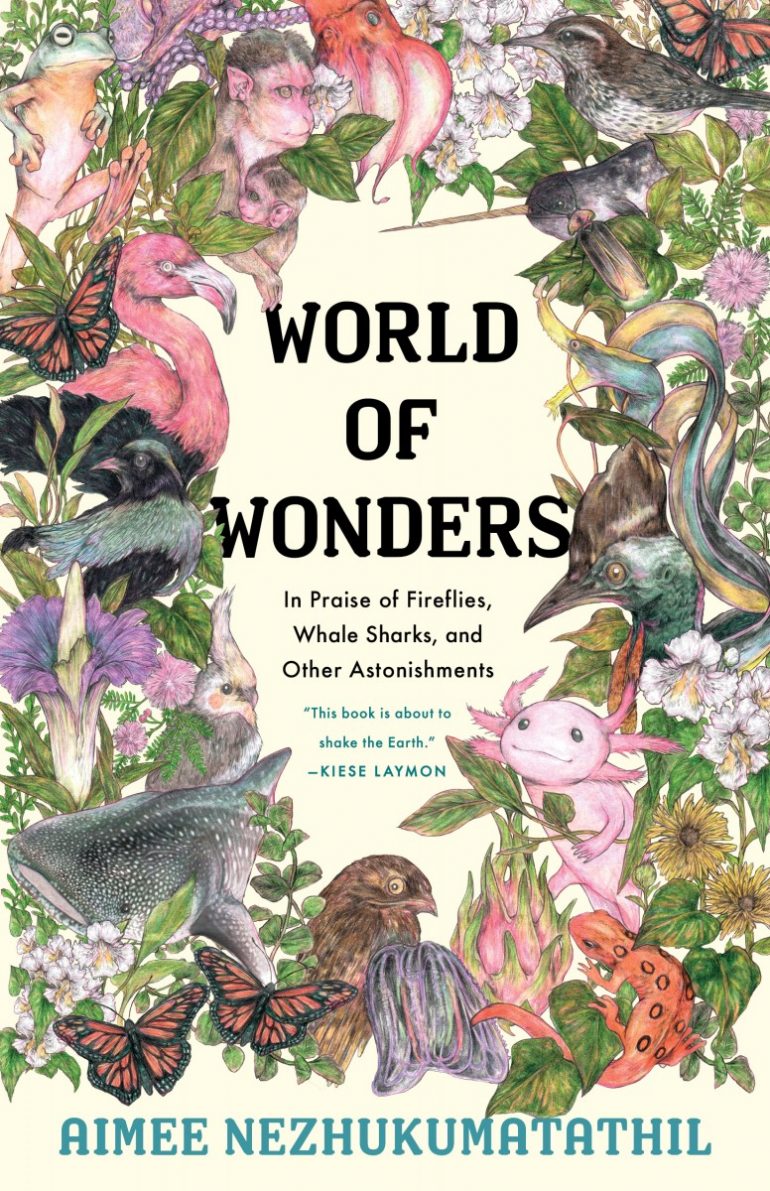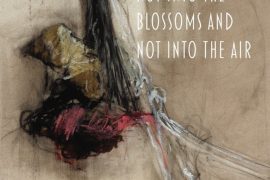It is winter in the Northern Hemisphere, and we are inside a moment of grand disconnection. Even if it were not for the pandemic, to be alive in the era of the Anthropocene is to be continually reminded of our role in the planet’s universal biology. The reminders—evidence of our impact in beneficial or harmful ways—rouse us to our innate bond with the living world, and usher us to utilize the most utopian capacities of our imaginations. To place ourselves inside this moment, yet also find the through lines, built of interconnectivity and belonging that will carry us into a future, is no small task, and Aimee Nezhukumatathil’s World of Wonders achieves just this.
A song, abundant and fertile in its connections, Nezhukumatathil weaves the self with nature into verdant, tactile relief. To read this work is to be rapt in the exquisite balm of seeing and believing in our capacity for planetary interconnectivity:
I’m in love with the idea that plants have a temperature, that they can run warm and cold when they need to, that they can send signals to species who will help them, not harm them. And what a magnificent telegraph we might send back, especially if other humans have ever made you feel alone on this earth.
Structured as an encyclopedic-biology-memoir, the tender sections of World of Wonders point in multiple directions at once, and explore the flora and fauna that dazzled Nezhukumatathil as a child, or offered a rich source of strength and resilience to her as a mother, wife, daughter, and teacher. At the hands of artist Fumi Mini Nakamura, each being is drawn exquisitely and in the style of the books of our childhoods. These representations twine our childlike selves with the magic of the animal kingdom and, most notably, through the eyes of a brown girl growing up in white America. Nezhukumatathil’s candid navigation of race and relationships enriches these lush catalogues, and is an illuminating feature among the book’s many stars.
The opening line situates us with the young author: “A catalpa can give two brown girls in western Kansas a green umbrella from the sun.” From this layered emblem begins the cataloguing of beings and elements sentient, of which Nezhukumatathil finds solace and inspiration through neighborhoods where her Filipina mother and Indian father are minorities, and she too must endure the scrutiny of America’s suburban white lens. We read of the young author in elementary school drawing in lively detail her favorite animal the peacock, an animal she fell in love with during trips to southern India. Singled out, she is scolded by a teacher for having “misunderstood the assignment.” “Some of us will have to start over and draw American animals. We live in Ah-mer-i-ka!” This scene breaks the heart. Deflated, she draws the most American thing she can think of: an eagle with a giant American flag hovering over the nest, and is declared the winner of the class competition. The “ridiculous, overly patriotic” drawing hangs in the hall for all to see. “I was a girl who loved to draw…I don’t think I ever drew a bird again, not even a doodle, until well into adulthood.”
To read these pages is to be engrossed in the recalled delights of Nezhukumatathil’s youth, but to simultaneously hold the hard truths that children of color growing up in America must bear. “If a white girl tries to tell you what your brown skin can and cannot wear for makeup, just remember the smile of an axolotl…The tighter your smile, the tougher you become.” She brings us to that place of viewership necessary for growth, of being a shared witness to the white-centric stories that need our collective transgressing, stories that limit children and limit us as a species. Of the axolotl’s ability to regenerate a severed limb, we are offered resilience: “An impossible wound begs to differ with its body and says, I’ve got another. And another.”
The range of interconnectivity in this work, the emotional registers of bonds to nature, family, and place, are nothing short of a synesthesia-like tapestry. Nezhukumatathil’s nonfiction debut is a beacon for the healing on offer to us, evidence of the richness available inside a life lived through connection, curiosity, and love. The environment, and us in it, has never been as wholly seen has she sees it, and we are reinvigorated, bolstered for her luminous analogies:
“The bibliography of the firefly is a tender and electric dress…”
“When I was single, the corpse flower was a way to help clear out the sleaze, the unsavory, the unpleasant—the weeds—of the dating world… I spent three years tracking blooming corpse flowers all over the world.”
Of the touch-me-not: “How I wish I could fold inward and shut down and shake off predators with one touch.”
Animals can open us in a way humans cannot. They can make us more dynamic in our connection to the planet and each other, to the spirit alive in every thing. World of Wonders is evidence of what is yielded from a life of opening one’s heart over and over again, to creatures that shimmer or squawk, or say nothing at all, but everything in volumes:
“The [whale] shark repeated her close encounters with me several more times during my snorkel session, even though there were five other snorkelers and two dive masters in the tank. Each time, I watched her giant eyeball, curious as a spaniel’s, turn toward my mask. Very rare to happen at all, let alone to the same person, said the dive master.”
Nezhukumatathil is a poet and writer gifted in the mosaic. This work shows up beyond the beauty and lushness of the natural world to embrace “the daily tragedies”: “…more children killed, the Amazon rainforest ablaze for weeks…I try to do what I can to help—donate money, gather bathroom supplies—but my heart longs for a place of tenderness.” In that moment is the cara cara orange, “the most precious offerings of her [mother and] father’s gardens[,]” given to and enjoyed deeply by her eldest son. She recalls group outings to bars with girlfriends in college, stories of young women being found dead, “like flamingos flying long-distance, mostly at night.” To this day, the author admits she says “a silent prayer” when she sees groups of young women out together and that, “There is a darkness beneath all dances of color.”
Of the many gifts Nezhukumatathil offers, most notable is her acknowledgement that connection is organic, and comes from the posture of our truest and most open selves. From a recent interview with The Adroit Journal, she writes: “It’s probably no surprise that any animal or plant I specifically first encountered with the sole intent to write about it for this collection didn’t end up in the book (green mamba, flamboyant cuttlefish, etc.). There was just a dullness, a flatness to the prose that I was never satisfied with, and I think I was simply trying to force connections inorganically.”
World of Wonders is a rare lens for softening the heart and a gift for the taking. We are granted entrance to our own reminders of aliveness and kinship through Nezhukumatathil’s maps, through a memoir that leaves the door open for us all.





